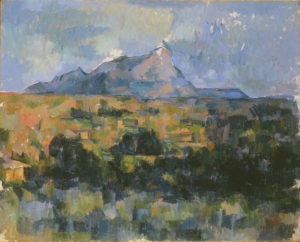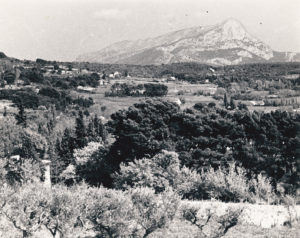R914 – La Montagne Sainte-Victoire vue des Lauves 1902-1906 (FWN354)
Pavel Machotka
(Cliquer sur les images pour les agrandir)
Cézanne’s response to the site in another early painting (R914-FWN354), where he stands further back and to the right and the season seems to be late summer, is flatter and more abstract; most of the patches are vertical or close to it, not only in the middle ground, but also in the foreground and the mountain. It is above all the difference in touch that makes this seem a different view, because in fact the views are quite close.
Rewald’s photographs shows olives in the foreground, which Cézanne depicts only as a foreground layer of silver which then passes over the sunburnt middle to the same colors in the mountain’s face. If there is deep space here, it is palpable only in the leap between the house and the mountain; and if there is tension, it is only in the exaggerated saddle of the mountain’s profile. In other respects the painting is more static and calls our attention to patterns; for example, the mountain’s shape is roughly reflected in the orange-brown middle.
Source: Machotka, Cézanne: The eye and the Mind.



